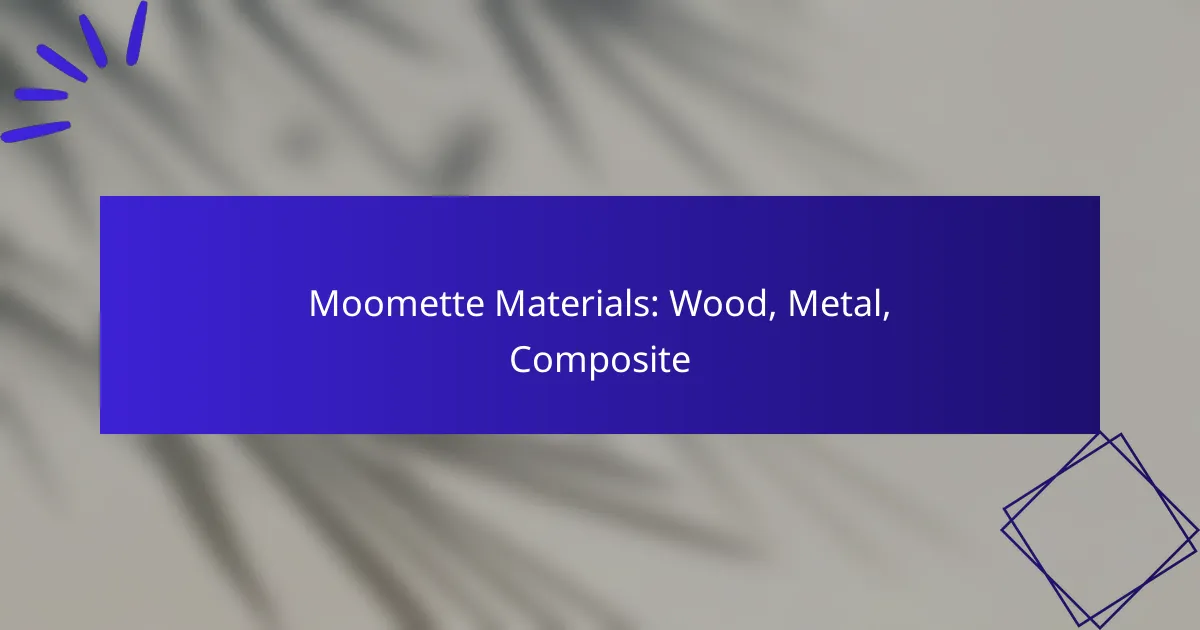Moomette materials, including wood, metal, and composite, are essential for construction, each providing unique advantages tailored to specific project needs. Understanding the characteristics of these materials, such as durability, strength, and cost, is crucial for making informed decisions that align with your project’s requirements.
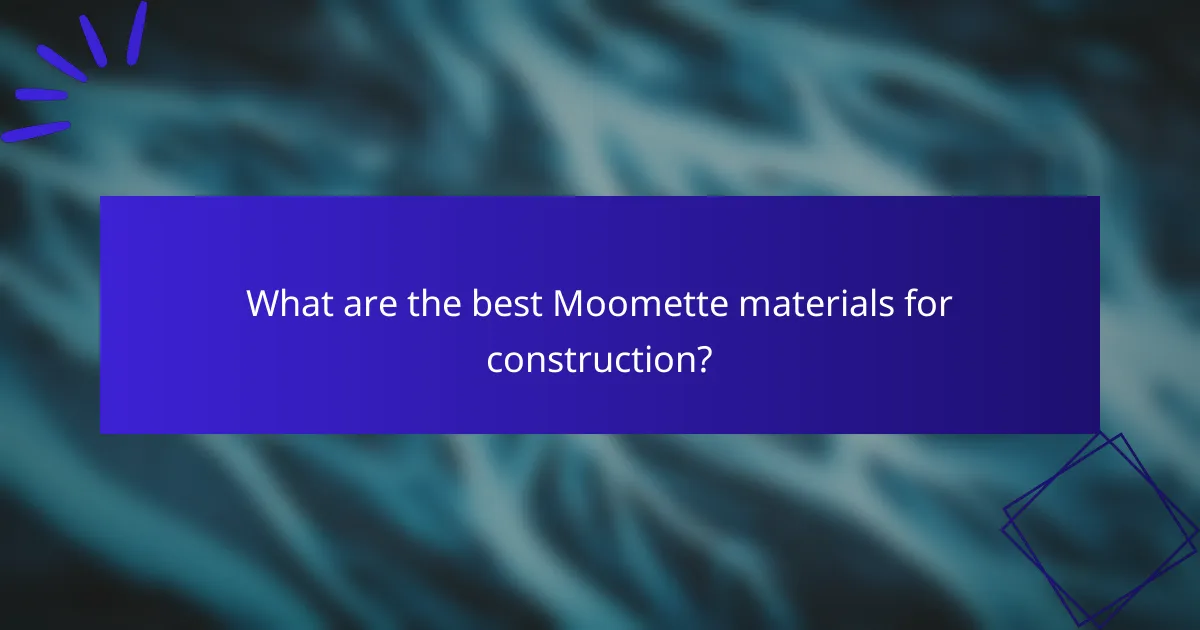
What are the best Moomette materials for construction?
The best Moomette materials for construction include wood, metal, and composite materials, each offering unique benefits. Choosing the right material depends on the specific requirements of your project, such as durability, strength, and versatility.
Wood for durability
Wood is a traditional choice for Moomette construction due to its natural durability and aesthetic appeal. It can withstand various environmental conditions when properly treated and maintained, making it suitable for both indoor and outdoor applications.
When selecting wood, consider species like cedar or redwood, which are naturally resistant to decay. Regular maintenance, such as sealing and staining, can extend the lifespan of wooden structures significantly.
Metal for strength
Metal materials, such as steel and aluminum, are favored for their exceptional strength and structural integrity. They can support heavy loads and resist deformation, making them ideal for high-stress applications in Moomette construction.
However, metal can be susceptible to corrosion, especially in humid environments. Using galvanized or stainless steel can mitigate this issue, ensuring longevity and reliability in various conditions.
Composite for versatility
Composite materials combine the best properties of wood and plastic, offering versatility and resistance to weathering. They are lightweight, easy to install, and require minimal maintenance, making them a practical choice for many construction projects.
When considering composites, look for products that are designed for specific applications, such as decking or siding, to ensure optimal performance. Their ability to mimic the appearance of wood while providing enhanced durability makes them a popular option.
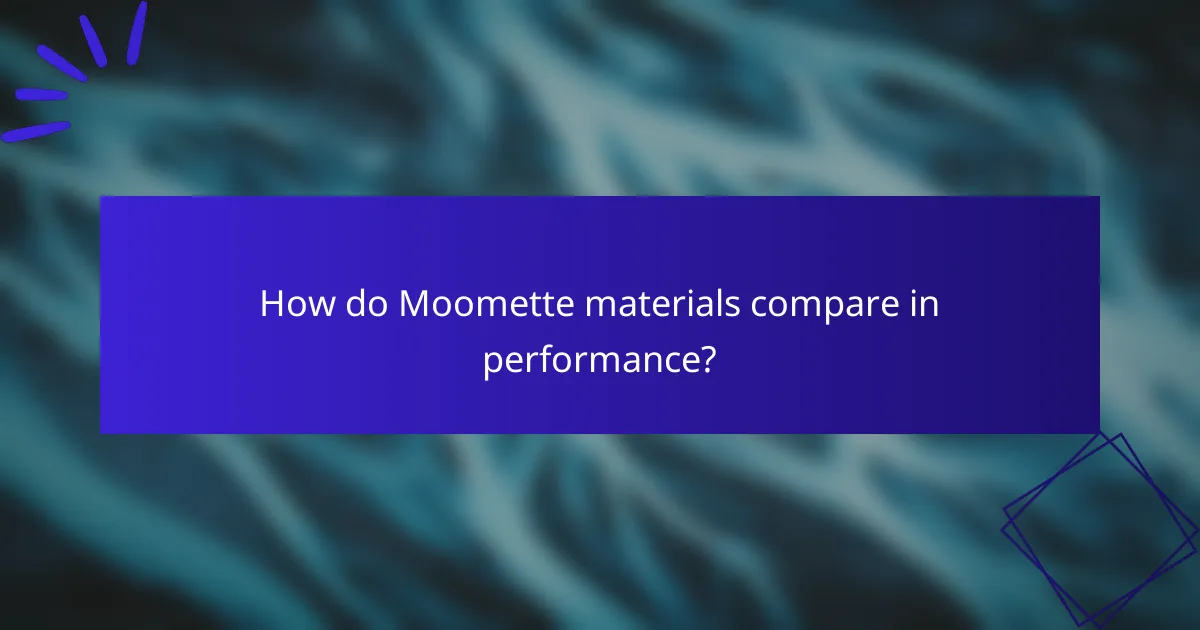
How do Moomette materials compare in performance?
Moomette materials, including wood, metal, and composite, each offer distinct performance characteristics that can impact their suitability for various applications. Understanding these differences helps in selecting the right material for specific needs, balancing factors like durability, weight, and cost.
Wood vs. Metal performance
Wood generally provides a lightweight and aesthetically pleasing option, making it ideal for applications where appearance matters. However, it can be susceptible to moisture and pests, which may compromise its longevity.
Metal, on the other hand, offers superior strength and durability, making it suitable for heavy-duty applications. It is resistant to many environmental factors but can be heavier and more expensive than wood. When choosing between wood and metal, consider the specific demands of your project, including load-bearing requirements and environmental exposure.
Composite vs. Wood performance
Composite materials combine the best properties of wood and synthetic materials, offering enhanced durability and resistance to moisture and decay. This makes composites a great choice for outdoor applications where wood might fail over time.
While wood can provide a natural look, composites often require less maintenance and can last significantly longer. When comparing composite to wood, evaluate the initial cost against long-term performance and maintenance needs to determine the best fit for your project.

What are the cost considerations for Moomette materials?
When evaluating Moomette materials, costs vary significantly based on the type of material chosen—wood, metal, or composite. Each material presents unique pricing factors influenced by availability, market demand, and specific project requirements.
Wood cost analysis
Wood is often one of the more affordable options for Moomette materials, with prices typically ranging from low tens to mid-hundreds of USD per cubic meter, depending on the type and quality. Common choices like pine or plywood are generally less expensive than hardwoods such as oak or maple.
Consider factors such as local sourcing and treatment costs, as these can affect overall expenses. Additionally, fluctuations in lumber prices due to market conditions can impact your budget significantly.
Metal pricing trends
Metal materials for Moomettes, such as aluminum or steel, usually come at a higher cost, often ranging from mid-hundreds to over a thousand USD per ton. Prices can vary based on the metal type, thickness, and finish required for your project.
Keep an eye on market trends, as metal prices can be volatile due to global supply chain issues. When budgeting, factor in potential price increases and consider bulk purchasing to mitigate costs.
Composite material expenses
Composite materials, which blend different materials for enhanced properties, often fall into a mid-range price category, typically between low hundreds to mid-hundreds of USD per square meter. Their cost reflects the benefits of durability and low maintenance.
When selecting composites, evaluate the long-term savings on maintenance and replacement, as these materials often last longer than traditional options. Be aware of the specific composite type, as prices can vary widely based on the formulation and intended use.
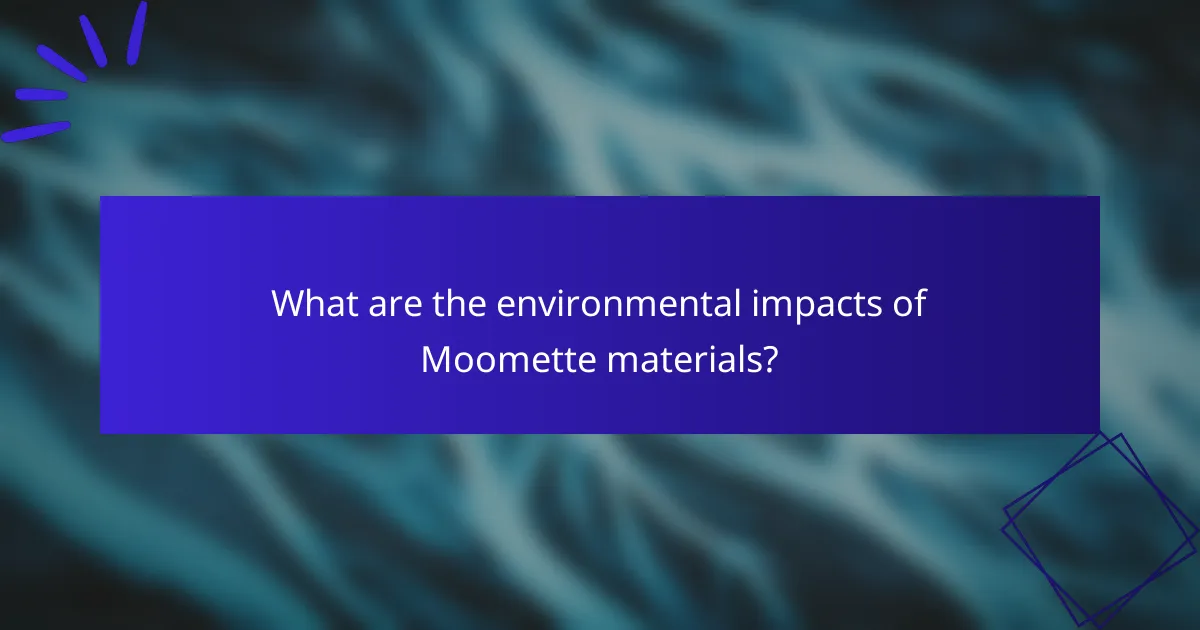
What are the environmental impacts of Moomette materials?
Moomette materials, including wood, metal, and composite, each have distinct environmental impacts that should be considered in their use and disposal. Understanding these impacts can help consumers make informed choices that align with sustainability goals.
Wood sustainability
Wood is often praised for its renewability, but its sustainability depends on responsible sourcing. Look for wood certified by organizations like the Forest Stewardship Council (FSC), which ensures that timber is harvested sustainably and responsibly.
When choosing wood products, consider the lifecycle impact, including the energy used in processing and transportation. Local sourcing can reduce carbon footprints significantly, making it a more eco-friendly option.
Metal recycling potential
Metal materials have a high recycling potential, which significantly reduces their environmental impact. Metals like aluminum and steel can be recycled multiple times without losing quality, making them a sustainable choice when sourced responsibly.
When selecting metal products, check for recycled content and local recycling facilities. Many regions have programs that encourage recycling, which can help minimize waste and conserve resources.
Composite environmental footprint
Composite materials can have a mixed environmental footprint, often combining the benefits of different materials. However, their recyclability can be limited, and disposal may pose challenges due to the mixture of materials used.
When using composites, consider their lifespan and potential for reuse. Research local regulations regarding disposal and recycling options to ensure that you are making environmentally sound choices.

What factors should be considered when choosing Moomette materials?
When selecting materials for Moomette, consider factors such as durability, weight, cost, and environmental impact. Each material type—wood, metal, or composite—offers unique advantages and trade-offs that can affect performance and suitability for specific applications.
Material properties
Wood is known for its natural aesthetic and good insulation properties, but it can be susceptible to moisture and pests. Metal, on the other hand, provides high strength and durability, making it ideal for structural applications, but it may require protective coatings to prevent corrosion.
Composite materials combine the best features of wood and metal, offering lightweight properties and resistance to environmental factors. However, they can be more expensive and may not be as readily recyclable as traditional materials.
Application suitability
For outdoor applications, metal and composite materials are often preferred due to their resistance to weathering. Wood can be used effectively in indoor settings where aesthetics are prioritized, but it may require regular maintenance to prevent degradation.
In terms of cost, wood is generally the most affordable option, while metal and composites tend to be pricier but offer longer lifespans. Consider the specific requirements of your project, such as load-bearing needs and exposure to elements, to determine the most suitable material.
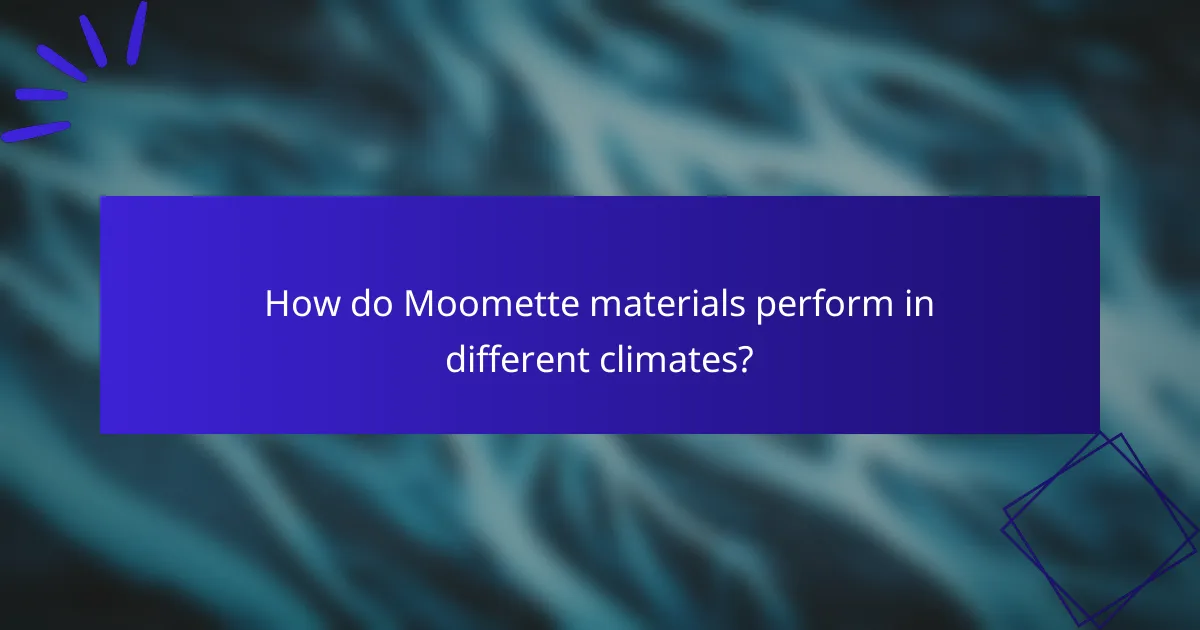
How do Moomette materials perform in different climates?
Moomette materials, including wood, metal, and composite, exhibit varying performance based on climate conditions. Understanding how each material reacts to humidity, salt exposure, and temperature extremes is crucial for ensuring durability and longevity.
Wood in humid climates
Wood is susceptible to moisture, which can lead to warping, mold, and decay in humid environments. Selecting rot-resistant species, such as cedar or redwood, can mitigate these risks. Regular maintenance, including sealing and staining, is essential to prolong the lifespan of wooden components.
Consider using pressure-treated wood for structural elements exposed to high humidity. This treatment helps prevent moisture absorption and enhances durability, making it a suitable choice for outdoor applications in humid regions.
Metal in coastal areas
Metal materials face significant challenges in coastal areas due to salt exposure, which can lead to corrosion. Stainless steel and aluminum are better choices for these environments as they offer enhanced resistance to rust and degradation. Regular inspections and maintenance can help identify early signs of corrosion.
Applying protective coatings or paints specifically designed for marine environments can further extend the life of metal components. Ensure that any fasteners or fixtures used are also corrosion-resistant to maintain structural integrity.
Composite in extreme temperatures
Composite materials are engineered to withstand extreme temperatures, making them versatile for various climates. They typically resist warping and cracking better than wood, ensuring stability in both hot and cold conditions. However, it is important to check the manufacturer’s specifications for temperature limits.
When using composite materials, consider their thermal expansion properties. Allow for adequate spacing during installation to accommodate expansion and contraction, which can prevent buckling or damage over time. Regular cleaning can also help maintain their appearance and performance in harsh climates.
